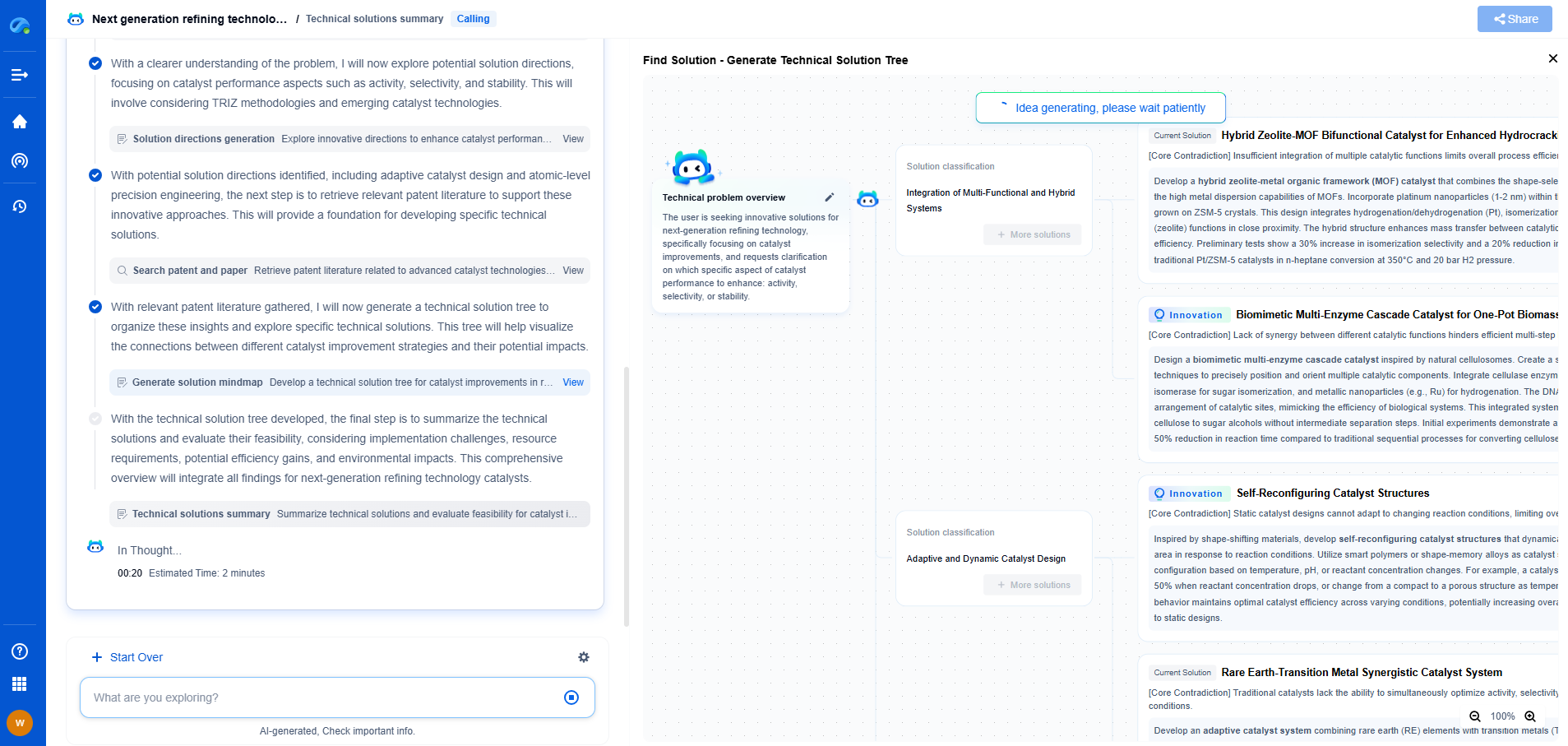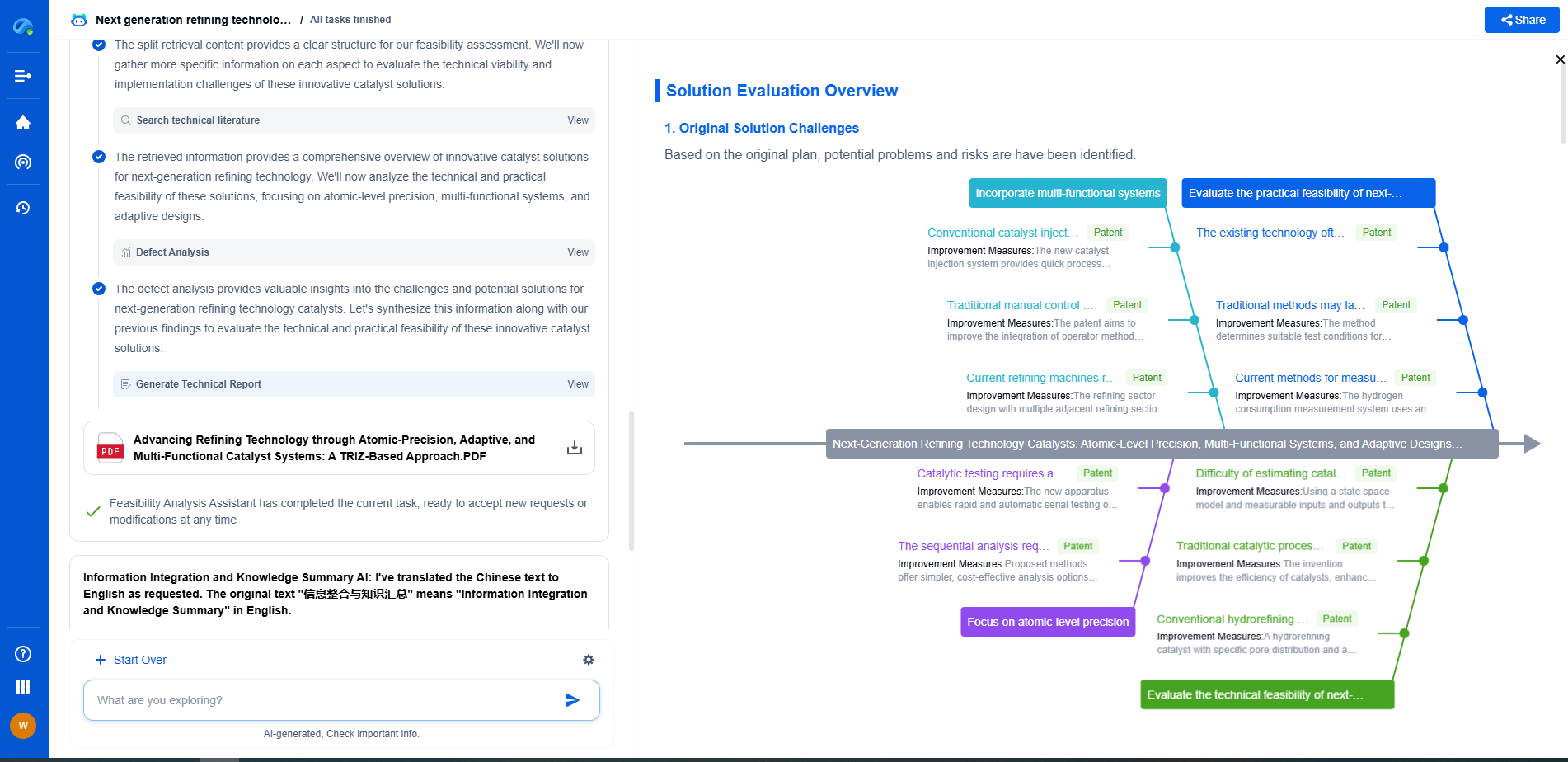The Effect of Polymer Chain Structure on Crystallization Behavior
JUL 3, 2025 |
Polymers are ubiquitous in modern materials science and daily life, playing key roles in everything from plastic packaging to high-performance fibers and biomedical devices. One critical aspect that influences the properties and applications of these materials is the structure of the polymer chains themselves. The architectural nuances of these chains—a result of molecular structure and configuration—profoundly affect their crystallization behavior, which in turn impacts the physical properties of the resultant polymer materials.
Types of Polymer Chain Structures
To understand how polymer chain structures influence crystallization behavior, it is essential to first identify the major types of polymer chain configurations. These include linear, branched, cross-linked, and network polymers:
1. **Linear Polymers**: These are composed of long, continuous chains without any branches. Examples include high-density polyethylene (HDPE) and polyvinyl chloride (PVC). The simplicity and regularity of the structure typically promote crystallinity, as the chains can align closely during the crystallization process.
2. **Branched Polymers**: These polymers have side chains branching off from the main chain. Low-density polyethylene (LDPE) is a common example. The presence of branches affects the ability of the chains to pack closely, often resulting in lower crystallinity compared to their linear counterparts.
3. **Cross-Linked Polymers**: In these structures, individual polymer chains are linked together by covalent bonds. Vulcanized rubber is a prime example. Cross-linking can restrict the movement of chains, impacting their ability to crystallize and often leading to increased amorphous regions.
4. **Network Polymers**: These have a three-dimensional network of interconnected polymer chains, such as in thermosetting plastics like epoxy resins. The extensive network structure typically hinders crystallization, resulting in predominantly amorphous materials.
Factors Influencing Crystallization
The crystallization behavior of polymers is influenced by several factors linked to their chain structure:
1. **Chain Flexibility**: Flexible chains, like those in linear polymers, can easily fold and pack into ordered structures, enhancing crystallinity. In contrast, rigid or bulky side groups, as seen in some branched polymers, can hinder this process.
2. **Tacticity and Stereoregularity**: The spatial arrangement of atoms within the polymer chain (tacticity), such as isotactic, syndiotactic, or atactic configurations, greatly affects crystallization. Isotactic polymers, with a regular stereochemical arrangement, tend to crystallize more easily than atactic polymers.
3. **Molecular Weight**: High molecular weight polymers typically exhibit slower crystallization rates due to increased chain entanglement and reduced chain mobility, affecting how the chains can organize into a crystalline structure.
4. **Cooling Rate**: The rate at which a polymer melt is cooled can dramatically influence crystallization. Fast cooling rates can trap polymers in a largely amorphous state, while slower cooling allows more time for crystallization to occur.
Impact on Physical Properties
The degree of crystallinity in a polymer significantly impacts its physical properties, including mechanical strength, thermal resistance, and optical clarity. Crystalline polymers often exhibit higher tensile strength and resistance to solvents and chemicals due to the dense packing of their chains. However, they may be less transparent compared to their amorphous counterparts, which scatter less light.
Applications and Implications
Understanding the relationship between polymer chain structure and crystallization behavior is crucial for polymer engineering and design. By manipulating chain architecture, scientists and engineers can tailor materials for specific applications, optimizing properties such as flexibility, toughness, and thermal stability. For instance, in the packaging industry, the balance between rigidity and flexibility can determine the suitability of a polymer for different types of containers and films.
Conclusion
The interplay between polymer chain structure and crystallization behavior is a foundational aspect of polymer science with wide-reaching implications in materials development and application. By delving into the molecular intricacies of polymer chains, researchers can continue to innovate and refine materials that meet the evolving demands of technology and industry. Understanding these dynamics not only enhances material performance but also drives the advancement of sustainable and efficient materials for the future.
Transform Polymeric Innovation with Patsnap Eureka
From biodegradable polymers to high-performance composites, the world of polymeric compounds is evolving faster than ever—driven by the demands of sustainability, functional customization, and global IP competition. Whether you're exploring novel copolymer architectures, optimizing polymerization techniques, or tracking material patents in bioplastics, time-to-insight is everything.
Patsnap Eureka, our intelligent AI assistant built for R&D professionals in high-tech sectors, empowers you with real-time expert-level analysis, technology roadmap exploration, and strategic mapping of core patents—all within a seamless, user-friendly interface.
Whether you're working on next-gen packaging films, bio-based resins, smart polymers for electronics, or new thermal-resistant composites, Eureka accelerates your journey from idea to patent to product—with unmatched clarity and speed.
🔍 Experience how Eureka can power your polymer R&D with AI intelligence—start your free trial today and unlock the future of materials innovation.
- R&D
- Intellectual Property
- Life Sciences
- Materials
- Tech Scout
- Unparalleled Data Quality
- Higher Quality Content
- 60% Fewer Hallucinations
Browse by: Latest US Patents, China's latest patents, Technical Efficacy Thesaurus, Application Domain, Technology Topic, Popular Technical Reports.
© 2025 PatSnap. All rights reserved.Legal|Privacy policy|Modern Slavery Act Transparency Statement|Sitemap|About US| Contact US: help@patsnap.com

